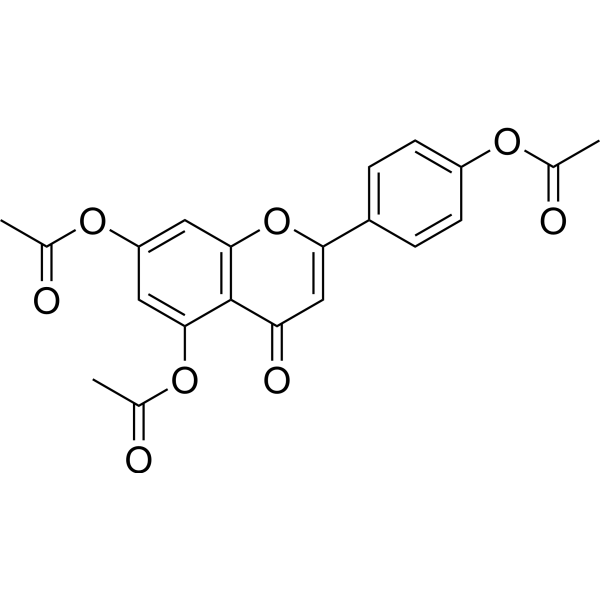
| 规格 | 价格 | |
|---|---|---|
| 500mg | ||
| 1g | ||
| Other Sizes |
| 靶点 |
Natural flavonoid
|
|---|---|
| 体外研究 (In Vitro) |
背景:
壳聚糖对小麦赤霉病(Fusarium head blight, FHB)有一定的防治效果。本研究的目的是比较盐酸壳聚糖在真菌接种前或真菌接种后对FHB的影响,并通过非靶向代谢组学研究更好地了解其作用模式。
结果:
壳聚糖在体外抑制了真菌的生长,接种前24 h,在接种后7、14和21 d,壳聚糖显著降低了小麦敏感品种Remus的侵染颖花数量。壳聚糖预处理显著提高了玉米的平均粒重、穗粒数和千粒重。接种后24小时喷施壳聚糖对籽粒产量没有显著影响,即使在每个时间点上确实导致侵染的小穗数量减少。利用UHPLC-QTOF-MS对小麦穗进行的非靶向代谢组学研究表明,同时喷洒壳聚糖和F. graminearum可激活已知的FHB抗性途径(如茉莉酸)。此外,与单独喷洒壳聚糖(51)或禾耳镰刀菌(32)相比,在穗上喷洒壳聚糖和禾耳镰刀菌孢子时,更多的代谢物被上调或下调(117)。这包括一种萜类化合物,一种萜类化合物和一种先前与FHB抗性相关的阈值。
结论:
本研究表明,盐酸壳聚糖在体外对禾本科赤霉病菌的孢子萌发和菌丝发育具有抑制作用,在预接种时可诱导小麦对赤霉病菌的抗性,并强调了壳聚糖、病原菌和两种药剂对小麦代谢产物和途径的共同和不同影响。这项研究为壳聚糖如何提供保护或刺激小麦抵抗禾粒镰刀菌感染提供了新的见解。它还揭示了在以前的食品血红蛋白或壳聚糖相关代谢组学研究中未列出的新的推定鉴定代谢物。[1]
|
| 参考文献 | |
| 其他信息 |
Acetic acid [4-(5,7-diacetyloxy-4-oxo-1-benzopyran-2-yl)phenyl] ester is a member of flavones.
In conclusion, this research showed that chitosan inhibited the spore germination and hyphal development of F. graminearum in vitro. Additionally, chitosan decreased FHB disease severity when applied as a spray inoculant on the spikes of the susceptible wheat cv. Remus, either pre- or post-fungal inoculation. However, it only reduced the yield loss caused by the infection when applied as a pre-inoculant. The untargeted metabolomic study determined that chitosan applied as a pre-inoculant had an impact on the metabolites within the wheat spikes, whether the plants had been inoculated with F. graminearum spores or not. Some of the putatively identified metabolites were consistent with previously published studies whereas several metabolites signatures of interest remain to be characterized. Validation studies are needed to confirm the pathways delineated in this study, and particularly the uncharacterized metabolites, and in vitro and in vivo experiments are needed to study the impact of metabolites of interest on the infection of plants by pathogens. Targeted measurements with higher throughput analytical methods and the use of reference compounds may help elucidate the defence mechanisms of plants growing under biotic stress conditions and also to validate the identification of all potential depicted metabolites. Finally, in agreement with previous studies, chitosan was proven to significantly reduce the impact of FHB in wheat, suggesting that a treatment could be optimised for field application. Further studies would be necessary to compare the effect of different types of chitosan and to determine an optimal time of application regarding infection. [1] |
| 分子式 |
C21H16O8
|
|---|---|
| 分子量 |
396.35
|
| 精确质量 |
396.085
|
| 元素分析 |
C, 63.64; H, 4.07; O, 32.29
|
| CAS号 |
3316-46-9
|
| PubChem CID |
18721
|
| 外观&性状 |
Typically exists as solid at room temperature
|
| 密度 |
1.356g/cm3
|
| 沸点 |
569.5ºC at 760mmHg
|
| 闪点 |
249.6ºC
|
| 折射率 |
1.587
|
| LogP |
3.235
|
| tPSA |
109.11
|
| 氢键供体(HBD)数目 |
0
|
| 氢键受体(HBA)数目 |
8
|
| 可旋转键数目(RBC) |
7
|
| 重原子数目 |
29
|
| 分子复杂度/Complexity |
704
|
| 定义原子立体中心数目 |
0
|
| SMILES |
C(OC1C2C(=O)C=C(C3C=CC(OC(=O)C)=CC=3)OC=2C=C(OC(=O)C)C=1)(=O)C
|
| InChi Key |
IVXFOQQPPONQTB-UHFFFAOYSA-N
|
| InChi Code |
InChI=1S/C21H16O8/c1-11(22)26-15-6-4-14(5-7-15)18-10-17(25)21-19(28-13(3)24)8-16(27-12(2)23)9-20(21)29-18/h4-10H,1-3H3
|
| 化学名 |
[4-(5,7-diacetyloxy-4-oxochromen-2-yl)phenyl] acetate
|
| 别名 |
Apigenin triacetate; 3316-46-9; APIGENINTRIACETATE; Triacetyl apigenin; [4-(5,7-diacetyloxy-4-oxochromen-2-yl)phenyl] acetate; 6LQX84KDOB; FLAVONE, 4',5,7-TRIHYDROXY-, TRIACETATE; 4',5,7-Triacetoxyflavone;
|
| HS Tariff Code |
2934.99.9001
|
| 存储方式 |
Powder -20°C 3 years 4°C 2 years In solvent -80°C 6 months -20°C 1 month |
| 运输条件 |
Room temperature (This product is stable at ambient temperature for a few days during ordinary shipping and time spent in Customs)
|
| 溶解度 (体外实验) |
May dissolve in DMSO (in most cases), if not, try other solvents such as H2O, Ethanol, or DMF with a minute amount of products to avoid loss of samples
|
|---|---|
| 溶解度 (体内实验) |
注意: 如下所列的是一些常用的体内动物实验溶解配方,主要用于溶解难溶或不溶于水的产品(水溶度<1 mg/mL)。 建议您先取少量样品进行尝试,如该配方可行,再根据实验需求增加样品量。
注射用配方
注射用配方1: DMSO : Tween 80: Saline = 10 : 5 : 85 (如: 100 μL DMSO → 50 μL Tween 80 → 850 μL Saline)(IP/IV/IM/SC等) *生理盐水/Saline的制备:将0.9g氯化钠/NaCl溶解在100 mL ddH ₂ O中,得到澄清溶液。 注射用配方 2: DMSO : PEG300 :Tween 80 : Saline = 10 : 40 : 5 : 45 (如: 100 μL DMSO → 400 μL PEG300 → 50 μL Tween 80 → 450 μL Saline) 注射用配方 3: DMSO : Corn oil = 10 : 90 (如: 100 μL DMSO → 900 μL Corn oil) 示例: 以注射用配方 3 (DMSO : Corn oil = 10 : 90) 为例说明, 如果要配制 1 mL 2.5 mg/mL的工作液, 您可以取 100 μL 25 mg/mL 澄清的 DMSO 储备液,加到 900 μL Corn oil/玉米油中, 混合均匀。 View More
注射用配方 4: DMSO : 20% SBE-β-CD in Saline = 10 : 90 [如:100 μL DMSO → 900 μL (20% SBE-β-CD in Saline)] 口服配方
口服配方 1: 悬浮于0.5% CMC Na (羧甲基纤维素钠) 口服配方 2: 悬浮于0.5% Carboxymethyl cellulose (羧甲基纤维素) 示例: 以口服配方 1 (悬浮于 0.5% CMC Na)为例说明, 如果要配制 100 mL 2.5 mg/mL 的工作液, 您可以先取0.5g CMC Na并将其溶解于100mL ddH2O中,得到0.5%CMC-Na澄清溶液;然后将250 mg待测化合物加到100 mL前述 0.5%CMC Na溶液中,得到悬浮液。 View More
口服配方 3: 溶解于 PEG400 (聚乙二醇400) 请根据您的实验动物和给药方式选择适当的溶解配方/方案: 1、请先配制澄清的储备液(如:用DMSO配置50 或 100 mg/mL母液(储备液)); 2、取适量母液,按从左到右的顺序依次添加助溶剂,澄清后再加入下一助溶剂。以 下列配方为例说明 (注意此配方只用于说明,并不一定代表此产品 的实际溶解配方): 10% DMSO → 40% PEG300 → 5% Tween-80 → 45% ddH2O (或 saline); 假设最终工作液的体积为 1 mL, 浓度为5 mg/mL: 取 100 μL 50 mg/mL 的澄清 DMSO 储备液加到 400 μL PEG300 中,混合均匀/澄清;向上述体系中加入50 μL Tween-80,混合均匀/澄清;然后继续加入450 μL ddH2O (或 saline)定容至 1 mL; 3、溶剂前显示的百分比是指该溶剂在最终溶液/工作液中的体积所占比例; 4、 如产品在配制过程中出现沉淀/析出,可通过加热(≤50℃)或超声的方式助溶; 5、为保证最佳实验结果,工作液请现配现用! 6、如不确定怎么将母液配置成体内动物实验的工作液,请查看说明书或联系我们; 7、 以上所有助溶剂都可在 Invivochem.cn网站购买。 |
| 制备储备液 | 1 mg | 5 mg | 10 mg | |
| 1 mM | 2.5230 mL | 12.6151 mL | 25.2302 mL | |
| 5 mM | 0.5046 mL | 2.5230 mL | 5.0460 mL | |
| 10 mM | 0.2523 mL | 1.2615 mL | 2.5230 mL |
1、根据实验需要选择合适的溶剂配制储备液 (母液):对于大多数产品,InvivoChem推荐用DMSO配置母液 (比如:5、10、20mM或者10、20、50 mg/mL浓度),个别水溶性高的产品可直接溶于水。产品在DMSO 、水或其他溶剂中的具体溶解度详见上”溶解度 (体外)”部分;
2、如果您找不到您想要的溶解度信息,或者很难将产品溶解在溶液中,请联系我们;
3、建议使用下列计算器进行相关计算(摩尔浓度计算器、稀释计算器、分子量计算器、重组计算器等);
4、母液配好之后,将其分装到常规用量,并储存在-20°C或-80°C,尽量减少反复冻融循环。
计算结果:
工作液浓度: mg/mL;
DMSO母液配制方法: mg 药物溶于 μL DMSO溶液(母液浓度 mg/mL)。如该浓度超过该批次药物DMSO溶解度,请首先与我们联系。
体内配方配制方法:取 μL DMSO母液,加入 μL PEG300,混匀澄清后加入μL Tween 80,混匀澄清后加入 μL ddH2O,混匀澄清。
(1) 请确保溶液澄清之后,再加入下一种溶剂 (助溶剂) 。可利用涡旋、超声或水浴加热等方法助溶;
(2) 一定要按顺序加入溶剂 (助溶剂) 。